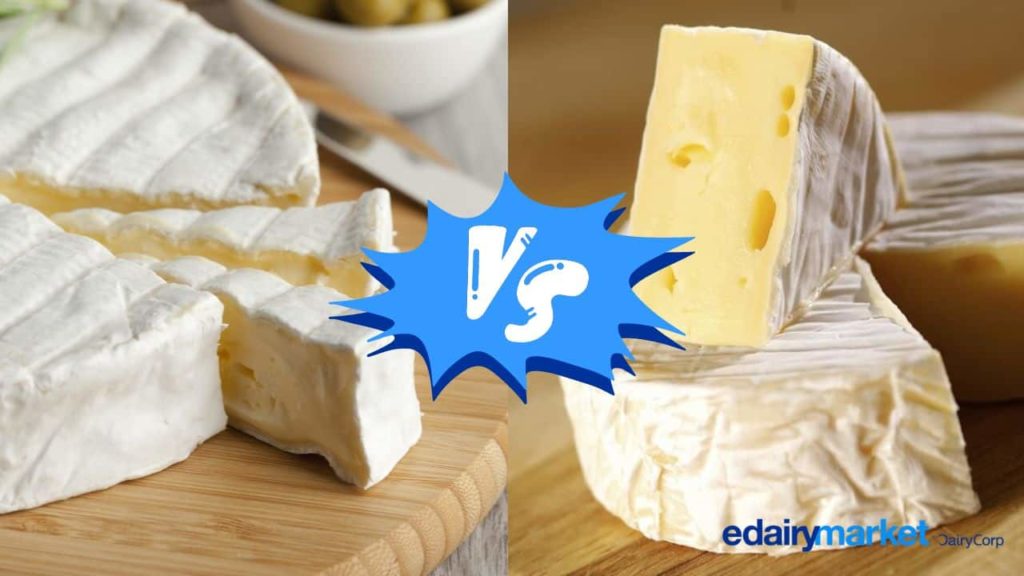
Today eDairy Market tells you about Brie and Camembert. They are two soft, creamy and sweet-toothed French cheeses that have a lot in common, but there are also some subtle differences that set them apart. Here are the main differences between Brie and Camembert:

1. Origin and region:
Brie: Brie cheese originates from the Ile-de-France region of France, specifically the Brie region near Paris. It is one of the best known French cheeses and has been produced for centuries.
Camembert: Camembert cheese, on the other hand, comes from the French region of Normandy. It was first made by Marie Harel at the end of the 18th century. Camembert is often associated with a slightly different flavor profile due to its specific geographical origin.
2. Size and shape:
Brie: Brie wheels are usually larger in diameter and wider than Camembert. Their diameter can range from 8 to 14 inches.
Camembert: Camembert wheels are usually smaller, with a diameter ranging from 4 to 6 inches. The smaller size can sometimes result in a slightly more intense flavor due to the higher cheese to rind ratio.
3. Texture and creaminess:
Brie: Brie tends to have a slightly firmer texture toward the center, becoming softer and creamier as it matures toward the rind. The texture is usually described as buttery and smooth.
Camembert: Camembert has a more consistent texture throughout the cheese, with a creamy, liquid interior that becomes more liquid as it matures.
4. Flavor and aroma:
Brie: Brie usually has a milder, more subtle flavor than Camembert. Its flavor is often described as buttery, with hints of mushrooms and earth. The aroma is also mild and pleasant.
Camembert: Camembert has a more robust and intense flavor profile. It can have earthy, mushroomy and sometimes slightly acidic notes. The aroma of Camembert is usually stronger and more pronounced.
5. Rind and appearance:
Brie: The rind of Brie is usually thin, edible and white, with a slightly velvety texture. As the cheese ages, the rind may develop more distinct flavors and aromas.
Camembert: The rind of Camembert is usually thicker and more velvety than that of Brie. It is also white and edible, but as the cheese matures, the rind may become more intense and even develop reddish or brownish streaks.
6. Time and intensity of ripening:
Brie: Brie cheese is usually ripened for less time than Camembert. The result is a milder flavor and less intense aroma. Brie is usually preferred by those who enjoy a more delicate cheesemaking experience.
Camembert: Camembert is aged for a longer period of time, allowing its flavors and aromas to develop and intensify. This makes it an option for those who enjoy stronger, more complex cheese flavors.
7. Preparation and recipe:
Brie: Traditional Brie production involves the use of raw milk, which can contribute to nuanced flavors and characteristics. However, many commercial Brie cheeses are made with pasteurized milk for safety reasons.
Camembert: Camembert is also often made with raw milk, which some believe contributes to its distinctive flavor. Like Brie, pasteurized versions are also available.
Pairing:

Both Brie and Camembert have creamy, smooth flavors, making them versatile when pairing with wine. Here are some wine options that complement these cheeses:
White wines:
Chardonnay: A classic choice, especially for Brie. The buttery notes of the cheese and wine harmonize perfectly.
Sauvignon Blanc: Its fresh acidity and citrus flavors can contrast with the richness of Brie or Camembert.
Red wines:
Pinot Noir: Often considered an excellent pairing for both Brie and Camembert because of its lighter body, red fruit flavors and soft tannins.
Gamay (Beaujolais): Another red wine option with a bright fruity flavor and soft tannins that can complement the creamy textures of these cheeses.
Sparkling wines:
Champagne or sparkling wine: The effervescence and acidity of sparkling wines can cleanse the palate between bites of creamy cheese and refresh the taste buds.
Sweet wines:
Sauternes or Late Harvest Wines: For a sweet pairing, these dessert wines can balance the richness of Brie or Camembert with their honeyed, fruity profiles.
Fortified wines:
Port or Sherry: These wines offer a combination of sweetness, dried fruit and complexity that can create an interesting contrast with cheeses.
Rosé wines:
Dry rosé: A versatile choice that can work with both Brie and Camembert, especially in the warmer months. Its light fruity flavor and acidity can complement the creaminess.
Which of the two cheeses do you prefer?
✅ At eDairy Market we have all the dairy categories, all the products and all the companies. We represent you.
✅ Power your business through eDairy Market:
- Your microsite with products, brand and domain of your company at a minimum cost.
- You will be able to sell your products and we do not charge you commission per sale.
- Now you can sell your Products, Ingredients and Dairy Machinery in English, Spanish, Portuguese and Mandarin Chinese.
✅ Create your own online store in a super easy way:


















